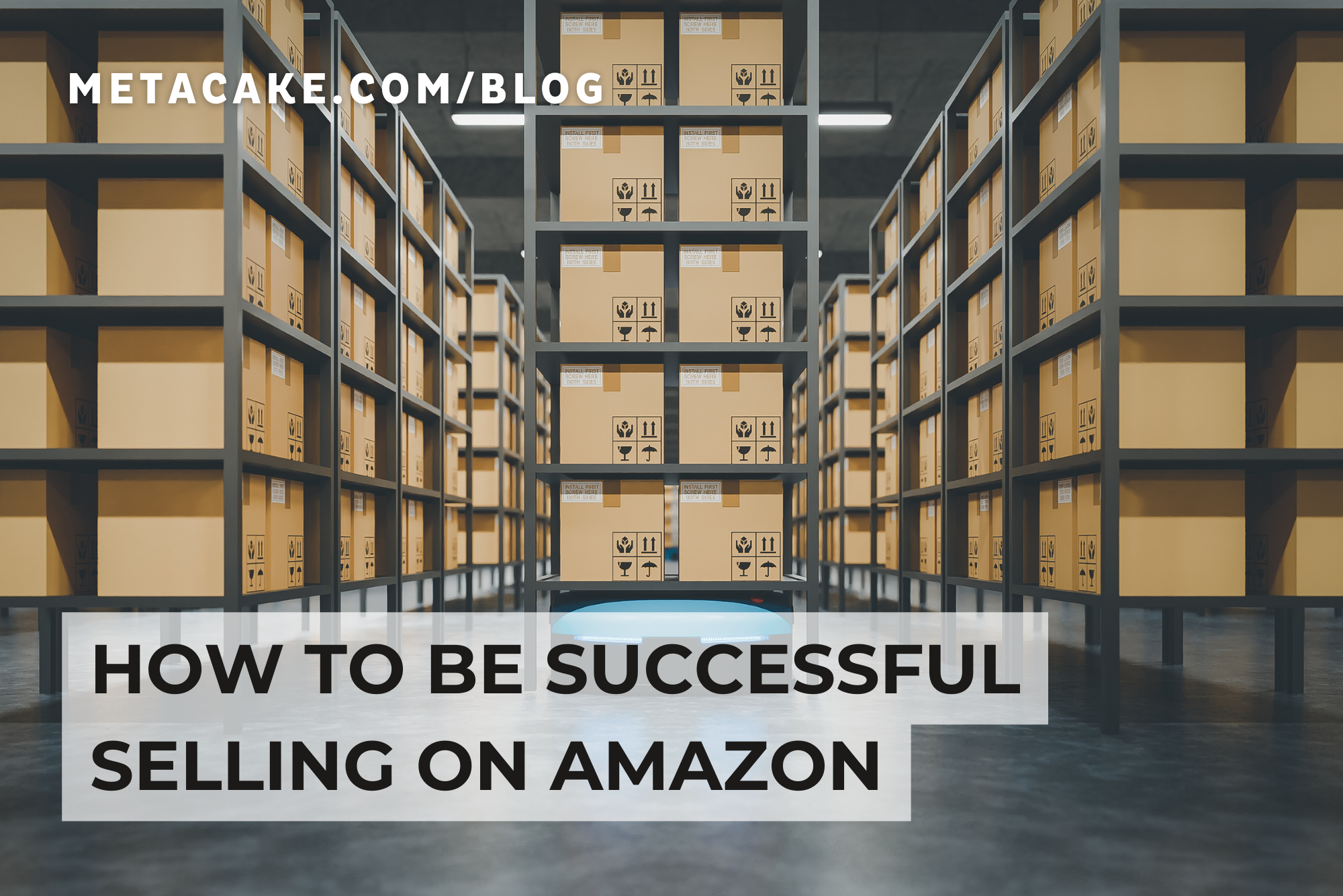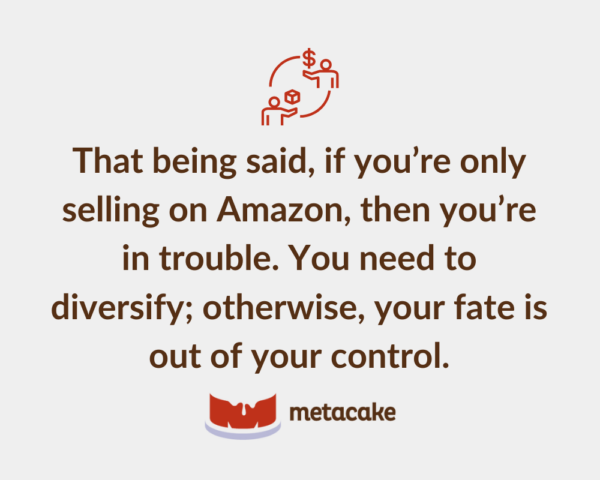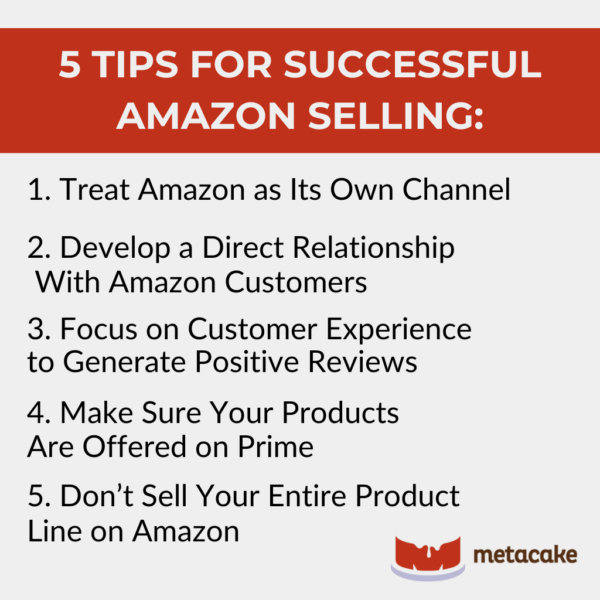
How to Be Successful Selling on Amazon
So, you’re officially a licensed ecommerce business and selling your products on Amazon. But how do you compete with a sea full of sellers and be successful?
Most ecommerce businesses that sell on Amazon have a love-hate relationship with this large and influential company, so rest assured that you’re not alone.
In this article, we’ll dive into what you need to know to be successful selling on Amazon.
Why Do Ecommerce Businesses Have a Love-Hate Relationship With Amazon?
Before we break down the sought-after insights into successfully selling on Amazon, let’s take a look at why ecommerce businesses both love and hate Amazon.
Lovers Gonna Love
Volume:
Amazon accounts for about half of all ecommerce sales in the U.S. Simply put, Amazon can drive serious sales. Whether a company only sells on Amazon or receives a small portion of sales through Amazon, Amazon driving sales is a good thing.
That being said, if you’re only selling on Amazon, then you’re in trouble. You need to diversify; otherwise, your fate is out of your control.
It’s important to diversify into other channels so you’re not solely dependent on Amazon (or any one single channel) — a channel that you ultimately don’t have control over.

Discovery:
Amazon is a comparison engine. It’s where people go to find the product that they want to buy. In the end, many customers make a decision and complete their purchase on Amazon.
However, many others then research other channels once they’ve made a product decision and purchase elsewhere. This makes Amazon a discovery channel where many potential customers become aware of your brand.
Keep a great reputation, and this’ll work in your favor.
Speed:
If there’s one thing that consumers know about Amazon, it’s that they receive their items quickly.
This is completely intentional, and Amazon has invested heavily in the logistics area, creating a customer experience that at times seems magical.
If you invest in Amazon as a brand and maintain Prime status, this can be a huge benefit.
Haters Gonna Hate
Channel Competition:
As a brand, we shouldn’t see Amazon as a competitor. However, from the channel’s perspective, it’s a different story.
Amazon competes with your direct channel (if you have one). This would be your ecommerce store.
Now let’s dig into this a bit. Amazon does not compete with you, but your Amazon channel does compete with your direct channel, aka your ecommerce website.
It’s important to make the point that your Amazon channel (while it’s ecommerce) is not your direct-to-consumer channel. It’s Amazon’s direct-to-consumer channel, and the customers are their customers. Got it?
Think of Amazon like you would a wholesale channel. They’re effectively a third-party retailer. If you’re a brand and you’re selling on Amazon and not on your own website, you’re not selling direct-to-consumer.
A little confusing, I know, but this is important to understand in order to create a successful strategy.
Customer Ownership:
Many Americans prefer to buy everything they can on Amazon, especially if they’re Prime members (which over 90 million American households are). It’s a one-stop shop for almost anything one could need.
Even if these customers are buying your product, they’re not your customers. They’re Amazon’s customers. You don’t own their data or control the customer experience.
This actually poses a huge problem because the true value of a customer is their lifetime value, not a single sale. We talk a lot about how the sale is just the beginning and that true success comes from creating a longtime customer who’s a raving fan.
You get to have some communication with the customer, but Amazon is very clear that these are their customers. Violate that, and you’ll be booted off.
It also creates stress because a few bad reviews on Amazon could completely tank your sales through this channel.
Customer Experience:
Now that we understand the customer ownership part of Amazon, it’s easy to understand the difference in customer experience.
The customer is Amazon’s customer, and therefore they get Amazon’s customer experience when unboxing products and interacting with the brand.
Yes, you control the package your product is in and respond to customer service issues, but only as it fits within their system. Don’t be fooled — this is Amazon’s customer experience, not yours.
This isn’t necessarily a bad thing. The Amazon customer experience is good, but if you want to create a more unique customer experience that’s designed around your brand, your values, your story, your content, and your service philosophies, that’s going to be a challenge.
Let’s say you’re a brand that has a unique unboxing experience coupled with post-purchase emails educating the customer on your product. You can’t create that same experience within Amazon.
Brand Competition:
There’s one area that your brand may butt heads with Amazon on, but it really only applies to a small percentage of merchants selling on Amazon.
The thing to be aware of is that Amazon owns the marketplace, but they also sell their own products on that very marketplace. And they have the right to see how your product sells and decide to make their own version of that very product (assuming they follow all patent laws, etc.).
Some may say this seems like a pretty unfair advantage. They own the market, the data, and can sell products that compete with your products on that very marketplace.
Well, it is an unfair advantage; however, that doesn’t make selling on Amazon a bad thing. It’s just something to be aware of.
Plus, a little competition never hurt anyone. Without it, what would push you to be better? 😉

How to Be a Successful Amazon Seller
As we know, we can’t beat Amazon, and we shouldn’t be trying to. Stop trying to compete. That’s the wrong mindset.
Let Amazon be Amazon, the one-stop shop for household conveniences. Instead of fighting, learn how to work with Amazon.
Here’s the good news: There are ways to leverage Amazon to complement your own ecommerce website and other sales channels. Here are five strategies that we use:
1. Treat Amazon as Its Own Channel
Think of Amazon the same way you would think of your wholesale channel. It needs a different strategy, different customer service staff, different managing staff, and different marketing staff.
It’s not the same as your DTC website and shouldn’t be treated as such. Everything from the way your products are presented on Amazon to the marketing strategy and customer service needs to be treated differently.
If you don’t have the resources to invest in Amazon this way, look for an outside agency that specializes in Amazon sales. It’ll be well worth it.
2. Develop a Direct Relationship With Amazon Customers
Find ways (that aren’t in violation of Amazon’s terms) to capture information about your Amazon customers so you can develop a direct relationship with them outside of Amazon.
As a brand, obviously, it’s ideal to control the customer experience. With Amazon, this isn’t possible, but there are ways to capture this customer data so you can communicate with them directly going forward.
Include an offer in your packaging for a discount on future products from your website, or ask people to register their products for a warranty.
Get creative here to capture the emails of your Amazon customers so you can build a relationship beyond this Amazon sale and capitalize on the lifetime value of this customer.
3. Focus on Customer Experience to Generate Positive Reviews
In ecommerce in general, social proof is one of the biggest factors in converting visitors. But on Amazon, reviews are even more important.
As we previously mentioned, Amazon is a comparison engine. While shoppers are also comparing features and benefits, typically when looking at comparable products, it’s going to come down to comparing reviews.
Bad reviews on Amazon can kill your Amazon sales almost entirely. If you only have three stars and your competitor has five, it’s hard to convince shoppers to buy from you instead.
Do everything you can to offer excellent customer service, especially to Amazon customers, to guarantee that you’ll consistently get strong reviews.
4. Make Sure Your Products Are Offered on Prime
The other main differentiator, apart from reviews, between different products on Amazon is whether or not your products qualify for Prime.
It’s estimated that more than half of all American households have a Prime membership. Prime is essentially the biggest benefit of shopping on Amazon. It offers a huge convenience to customers.
Prime members are much less likely to purchase your product if it’s not on Prime, so make sure you qualify.
Beyond that, make sure to offer expedited shipping on your own site for free or comparable discounts to make purchasing from your DTC channel at least as attractive, if not more attractive, than shopping on Amazon.
5. Don’t Sell Your Entire Product Line on Amazon
A strategy that works well for most brands is to offer a limited product line (perhaps your most popular products) on Amazon and then offer more variety and other options only on your own ecommerce website.
This allows you to use the benefit of customers discovering your products on Amazon, which gives them a reason to buy from you directly as well.
The key here is that you’ll have to work to make the customer aware of that extended line of products.
The Bottom Line
Your ecommerce store and Amazon are entirely different. Your store offers a tailored experience compared to the marketplace nature of Amazon.
Provide a rich brand experience on your site and a sweet deal on your products to complement your Amazon sales. Instead of fighting against Amazon, play along nicely.
Doing Amazon well doesn’t mean that you’re cannibalizing all your own sales. See it as channel diversification, which is a healthy aspect of any business.
So, are you feeling more confident? Are you ready to be successful selling on Amazon? If you’re not quite there yet and need an expert to help guide you the rest of the way, just give us a shout!



